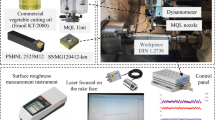Abstract
Serrated chip formation influences almost every aspect of a high-speed cutting (HSC) process. This paper aims to develop a reliable method to accurately predict such chip formation processes. To this end, a systematic finite element analysis was carried out and a series of HSC experiments were conducted on a heat treated AISI 1045 steel. It was found that the integrative use of the Johnson–Cook thermal-viscoplastic constitutive equation, Johnson–Cook damage criterion for chip separation, and the modified Zorev’s friction model can precisely predict the serrated chip formation in HSC without artificial assumptions. This advancement has removed the major barrier in the current machining investigations by numerical simulation. The present study also found that the tool rake angle has a significant effect on serrated chip formation. As the rake angle increases, the chip sawtooth degree and cutting forces decrease, but the chip segmentation frequency increases.
Similar content being viewed by others
References
Klocke F, Raedt HW, Hoppe S (2001) 2D-FEM simulation of the orthogonal high speed cutting process. Mach Sci Technol 5(3):323–340
Baker M, Rosier J, Siemers C (2002) A finite element model of high speed metal cutting with adiabatic shearing. Comput Struct 80:495–513
Baker M (2006) Finite element simulation of high-speed cutting forces. J Mater Process Technol 176:117–126
Hortig C, Svendsen B (2007) Simulation of chip formation during high-speed cutting. J Mater Process Technol 186:66–76
Rhim S, Oh S (2006) Prediction of serrated chip formation in metal cutting process with new flow stress model for AISI 1045 steel. J Mater Process Technol 171:417–422
Ng EG, EI-Wardany TI, Dumitrescu M, Elbestawi MA (2002) Physics-based simulation of high speed machining. Mach Sci Technol 6:301–329
Umbrello D (2008) Finite element simulation of conventional and high speed machining of Ti6Al4V alloy. J Mater Process Technol 196:79–87
Johnson GR, Cook WHA (1983) Constitutive model and data for metals subjected to large strain, high strain rates, and high temperature. In: Proceedings of the 7th International Symposium on Ballistics, Hague, the Netherlands, pp 541–547
Zerilli FJ, Armstrong RW (1987) Dislocation-mechanics-based constitutive relations for material dynamics calculation. J Appl Phys 5:1816–1825
Gao CY, Zhang LC (2010) A constitutive model for dynamic plasticity of FCC metals. Mater Sci Eng A 527:3138–3143
Davies MA, Cao Q, Cooks AL (2003) On the measurement and prediction of temperature fields in machining AISI 1045 Steel. CIRP Ann Manuf Technol 52(1):77–80
Li GH (2009) Prediction of adiabatic shear in high speed machining based on linear pertubation analysis. Ph.D thesis, Dalian University of Technology, China
Komvopoulos K, Erpenbeck AS (1991) Finite element modeling of orthogonal metal cutting. ASME J Eng Ind 113:253–267
Lin ZC, Lo SP (1997) Ultra-precision orthogonal cutting simulation for oxygen-free high-conductivity copper. J Mater Process Technol 55:281–291
Mamalis AG, Horvath M, Branis AS, Manolakos DE (2001) Finite element simulation of chip formation in orthogonal metal cutting. J Mater Process Technol 110:19–27
Huang JM, Black JT (1996) An evaluation of chip separation criteria for the FEM simulation of machining. J Manuf Sci Eng 118:545–554
Shet C, Deng X (2003) Residual stresses and strains in orthogonal metal cutting. Int J Mach Tools Manuf 43:573–587
Li K, Gao XL, Sutherland JW (2002) Finite element simulation of the orthogonal metal cutting process for qualitative understanding of the effects of crater wear on the chip formation process. J Mater Process Technol 127:309–324
Strenkowski JS, Carroll JT (1985) A finite element model of orthogonal metal cutting. ASME J Eng Ind 107:349–354
Xie JQ, Bayoumi AE, Zbib HM (1998) FEA modeling and simulation of shear localized chip formation in metal cutting. Int J Mach Tools Manuf 38:1067–1087
Lin ZC, Pan WC (1993) Thermoelastic plastic large deformation model for orthogonal cutting with tool flank wear, part I: computational procedures. Int J Mech Sci 35:829–840
Lin ZC, Lin YY (2001) A study of oblique cutting for different low cutting speeds. J Mater Process Technol 115:313–325
Zhang LC (1999) On the separation criteria in the simulation of orthogonal metal cutting using the finite element method. J Mater Process Technol 89–90:273–278
Pantale O, Bacaria JL, Dalverny O, Rakotomalala R, Caperaa S (2004) 2D and 3D numerical models of metal cutting with damage effects. Comput Methods Appl Mech Eng 193:4383–4399
Mabrouki T, Rigal JF (2006) A contribution to a qualitative understanding of thermo-mechanical effects during chip formation in hard turning. J Mater Process Technol 176:214–221
Vaziri MR, Salimi M, Mashayekhi M (2010) A new calibration method for ductile fracture models as chip separation criteria in machining. Simul Mod Pract Theory 18:1286–1296
Cockroft MG, Latham DJ (1968) Ductility and workability of metals. J Inst Met 96:33–39
McClintock FA (1968) A criterion for ductile fracture by the growth of holes. J Appl Mech 35:363–371
Johnson GR, Cook WH (1985) Fracture characteristics of three metals subjected to various strains, strain rates, temperatures and pressures. Eng Fract Mech 21(1):31–48
Zorev NN (1963) Inter-relationship between shear processes occurring along tool face and shear plane in metal cutting. International Research in Production Engineering ASME: International Production Engineering Research Conference, Pittsburgh, pp 42–49
Ozel T, Altan T (2000) Determination of workpiece flow stress and friction at the chip–tool contact for high-speed cutting. Int J Mach Tools Manuf 40:133–152
Schulz H, Abele E, Sahm A (2001) Material aspects of chip formation in HSC machining. CIPP Ann-Manuf Technol 50(1):45–48
Zhao QT, Wu GQ, Sha W (2010) Deformation of titanium alloy Ti–6Al–4V under dynamic compression. Comput Mater Sci 50(2):516–526
Sun J, Guo YB (2009) Material flow stress and failure in multiscale machining titanium alloy Ti–6Al–4V. Int J Adv Manuf Technol 41(7–8):651–659
Author information
Authors and Affiliations
Corresponding author
Rights and permissions
About this article
Cite this article
Duan, C., Zhang, L. A reliable method for predicting serrated chip formation in high-speed cutting: analysis and experimental verification. Int J Adv Manuf Technol 64, 1587–1597 (2013). https://doi.org/10.1007/s00170-012-4125-0
Received:
Accepted:
Published:
Issue Date:
DOI: https://doi.org/10.1007/s00170-012-4125-0




